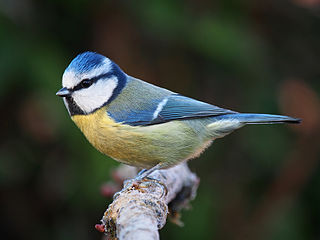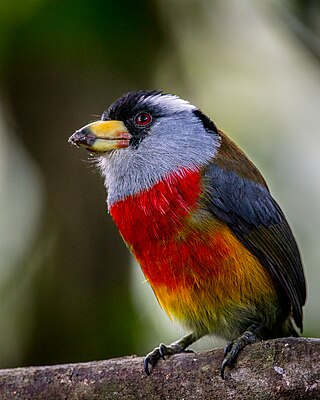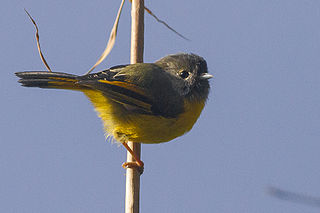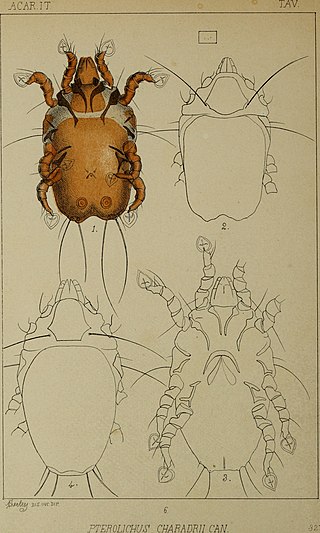| Proctophyllodes | |
|---|---|
 | |
| Female and male Proctophyllodes polyxenus | |
| Scientific classification | |
| Kingdom: | |
| Phylum: | |
| Class: | |
| Order: | |
| Family: | |
| Genus: | Proctophyllodes Robin, 1868 |
Proctophyllodes is a genus of feather mites, found on passerine birds.
| Proctophyllodes | |
|---|---|
 | |
| Female and male Proctophyllodes polyxenus | |
| Scientific classification | |
| Kingdom: | |
| Phylum: | |
| Class: | |
| Order: | |
| Family: | |
| Genus: | Proctophyllodes Robin, 1868 |
Proctophyllodes is a genus of feather mites, found on passerine birds.

The bulbuls are members of a family, Pycnonotidae, of medium-sized passerine songbirds, which also includes greenbuls, brownbuls, leafloves, and bristlebills. The family is distributed across most of Africa and into the Middle East, tropical Asia to Indonesia, and north as far as Japan. A few insular species occur on the tropical islands of the Indian Ocean. There are 166 species in 32 genera. While different species are found in a wide range of habitats, the African species are predominantly found in rainforest, whereas Asian bulbuls are predominantly found in more open areas.

The Eurasian blue tit is a small passerine bird in the tit family, Paridae. It is easily recognisable by its blue and yellow plumage and small size.

Ovenbirds or furnariids are a large family of small suboscine passerine birds found from Mexico and Central to southern South America. They form the family Furnariidae. This is a large family containing around 315 species and 70 genera. The ovenbird, which breeds in North America, is not a furnariid – rather it is a distantly related bird of the wood warbler family, Parulidae.

The woodcreepers (Dendrocolaptinae) comprise a subfamily of suboscine passerine birds endemic to the Neotropics. They have traditionally been considered a distinct family Dendrocolaptidae, but most authorities now place them as a subfamily of the ovenbirds (Furnariidae). They superficially resemble the Old World treecreepers, but they are unrelated and the similarities are due to convergent evolution. The subfamily contains 63 species in 16 genera.

The Tyranni (suboscines) are a suborder of passerine birds that includes more than 1,000 species, the large majority of which are South American. It is named after the type genus Tyrannus.

The toucan barbet is a barbet native to western Ecuador and Colombia. Along with the prong-billed barbet, it forms the family Semnornithidae, and is closely related to the toucans. It is a medium-sized barbet with a robust yellow bill. It has striking plumage, having a black head with grey throat and nape, red breast and upper belly, yellow lower belly and grey wings and tail.

The yellow-rumped flycatcher, also known as Korean flycatcher or tricolor flycatcher, is a species of flycatcher found in eastern Asia. A distinctive species with almost no look-alike other than the narcissus flycatcher. It breeds in eastern Asia including parts of Mongolia, Transbaikal, southern China, Korea and western Japan. They winter in parts of the Malay Peninsula and South Asia.

The tetrakas and allies are a newly validated family of songbirds. They were formally named Bernieridae in 2010. The family currently consists of eleven species of small forest birds. These birds are all endemic to Madagascar.

Feather mites are the members of diverse mite superfamilies:

The golden-breasted fulvetta is a species of songbird found in Bhutan, China, India, Myanmar, Nepal, and Vietnam. Its natural habitats are temperate forests and subtropical or tropical moist montane forests.

The many-colored rush tyrant or many-coloured rush tyrant is a small passerine bird of South America belonging to the tyrant flycatcher family, Tyrannidae. It is the only member of the genus Tachuris and is sometimes placed in a separate monotypic family. It inhabits marshland and reedbeds around lakes and rivers. It is particularly associated with stands of Scirpus. The nest is built among plant stems.

The Proctophyllodidae are a family of the Acarina (mite) order Astigmata. They contain many feather mites. The Alloptidae and Trouessartiidae were in earlier times included here as subfamilies.

Conogethes is a genus of moths in the subfamily Spilomelinae of the family Crambidae. The currently 17 recognized species are distributed in the Indomalayan and Australasian realm.

Rhinonyssidae is a family of mites in the order Mesostigmata. There are about 16 genera and at least 460 described species in Rhinonyssidae.

Syringophilidae is a family of mites, commonly known as quill mites. They are obligatory ectoparasites of birds, and inhabit their feather quills where they feed on subcutaneous tissue and fluids. Typically the Syringophilinae inhabit all but the body feathers, while the Picobinae specialize in infecting the body feathers internally. Quill mites have been recorded from hundreds of bird species, belonging to 95 families and 24 orders. Much knowledge of their hosts, diversity and systematics has been obtained since the late 1990s, but as of 2020 these were still considered to be poorly known.

Avenzoariidae is a family of feather mites in the order Astigmata. There are at least 15 genera in Avenzoariidae. They are found on the feathers of aquatic birds, and in the case of one species, birds of prey.

Glyphanoetus is a genus of astigs in the family Histiostomatidae.

Linopodes is a cosmopolitan genus of mites in the family Cocceupodidae. There are at least two described species.

Stenochrus portoricensis is a species of arachnid belonging to the family Hubbardiidae in the order Schizomida, which are commonly known as short-tailed whip scorpions. They are mostly found in North and Central America, but their parthenogenetic lifestyle allows them to live in other parts of the world in temperate climates. They are able to thrive in different parts of the world, especially in caves, forests, fallen logs, and abandoned nests of termites.

The Indochinese blue flycatcher is a species of bird in the family Muscicapidae. It is found from southern Myanmar and the Malay Peninsula to Indochina and northeastern Sumatra. It was previously considered conspecific with Tickell's blue flycatcher.